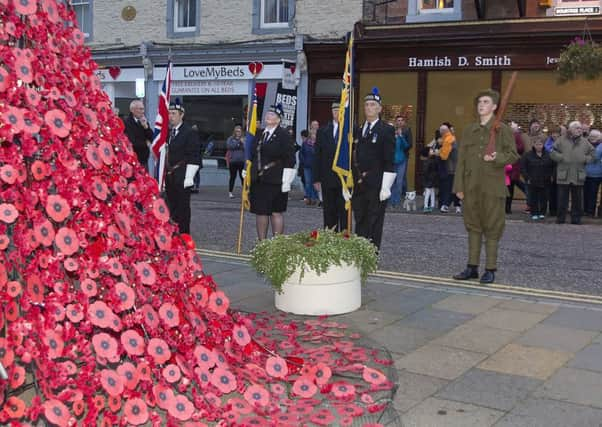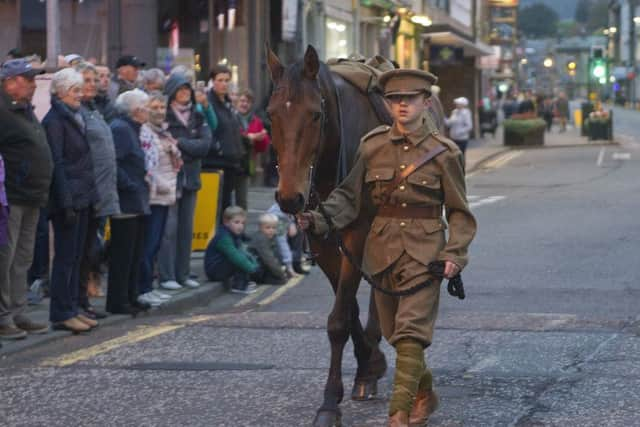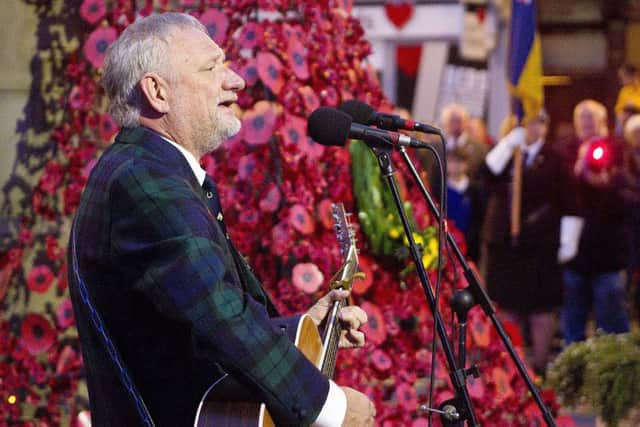Hawick pays tribute to famed sculptor 100 years after his death


Hundreds of Teries turned out to honour William Beattie, the sculptor responsible for creating the town’s 1514 memorial on High Street in 1914.
The Hawick Scout and Hawick pipe bands, Saxhorn Band and the Drum and Fifes led a parade of standard bearers, hundreds of followers and a single lone horse along High Street before a poignant ceremony at the memorial.
Advertisement
Hide AdAdvertisement
Hide AdHonorary provost Watson McAteer paid tribute to Hawick-born Beattie, whose commissioned memorial was unveiled on the 400th anniversary of the 1514 skirmish at Hornshole.


“We remember in sadness a revered and very humble son of Hawick, but also with great pride, a young man whose talents, skills and heroism have left an indelible mark on each and every one of us,” he said. “This symbol of William Beattie’s work and more importantly his expressed passion for our town and its history has remained a rallying point for Teris, at home and abroad, since it was unveiled on June 4, 1916 in front of thousands of excited townsfolk by Lady Cybil Scott.
“While the horse was symbolic of strength and determination, the memorial triumphs the return of a young callant proudly holding high the banner so bravely won at Hornshole.
“It’s that young callant that William Beattie has preserved for our future and it’s his exploits, and those of his predecessors, that we guard as we remember over 500 years of a turbulent history of our proud Scottish town.”
Advertisement
Hide AdAdvertisement
Hide AdWilliam Beattie was born on November, 23, 1886, at Slitrig Bank, and followed in his father’s footsteps to become a sculptor, studying at Edinburgh’s George Watson’s College then its College of Art.


“William Beattie was not one for letting the grass grow under his feet, and at 25 was running his own business as a sculptor, and ultimately landed the prize of being commissioned to design a memorial for his won town,” Mr McAteer added. “Before us, stands the legacy of that commission - a memorial destined to celebrate the history of Hawick and to immortalise the name of William Beattie.”
He served with the Territorial Army before the war and was immediately commissioned to the Lothian and Border Horse in 1914, before joining the Royal Field Artillery in April 1915, then the Seventh Royal Horse Artillery Brigade on the western front after that. He fought at Loos, Ypres and the Somme and was awarded the Military Cross in November 1917.
“I wonder how often during these difficult and dangerous times he quietly thought about Hawick, the horse and the brave callant he sculpted,” Mr McAteer added. “He would have remembered exactly why his memorial was such an important part of our history, but more importantly reflected on that young man sitting astride a tired horse, returning home triumphant, despite the odds.”
Advertisement
Hide AdAdvertisement
Hide AdBut Beattie did not return. He died, aged 31, of battle wounds at a field hospital near Joncourt in northern France on October 3, 1918, weeks before the end of the First World War.
100 years later, tonight, a wreath was laid by Hawick Cornet Gareth Renwick, at the 1514 memorial, while the Saxhorn Band played ‘The Invocation’.
Lone piper Robert Scott’s performance of Teribus signalled the start of a contemplative silence, broken one minute later by Michael Aitken, with a verse and chorus of the same song.
Hawick singer and songwriter Alan Brydon performed ‘A Place in my Heart’, a song written from the perspective of a Hawick solder thinking of home.
Advertisement
Hide AdAdvertisement
Hide AdOne of the dozen-strong organising team, Ian Landles, said afterwards: “I’m delighted with the way tonight has gone. There’s been a great turn out of folk, which we had hoped for.
“We have definitely done justice to a great man who was cut down in his prime like so many of his generation.
“It’s a wonderful statue, some say one of the best equine statues in Britain, and the cascade of poppies attached to it tonight is incredible.”
Hawick Cornet Gareth Renwick added: “It was really a very emotional and sombre event.
Advertisement
Hide AdAdvertisement
Hide Ad“It’s good to be able to remember William Beattie and there not many other places can do it like we do it.
“The horse looks unbelievable.
“It was a privilege being able to lay the wreath, it’s a little bit of history made and I think everybody who turned out tonight enjoyed it.”
Mr McAteer added: “I thank each and every one of you for joining us at this unique and very special event for the town.
“It’s been a great privilege to work with an organising committee who I’d like to thank on your behalf for their time and commitment to make this a night to remember.
Advertisement
Hide AdAdvertisement
Hide Ad“To the many clubs and organisations who have supported this financially as well as morally, thank you.
“I must also single out Judith Murray and Lesley Fraser and their team of patient volunteers who spent many hours creating the wonderful poppy flow at the front of the horse
“What a fitting tribute of remembrance to William Beattie and all those other Hawick folk who have paid the ultimate sacrifice.”